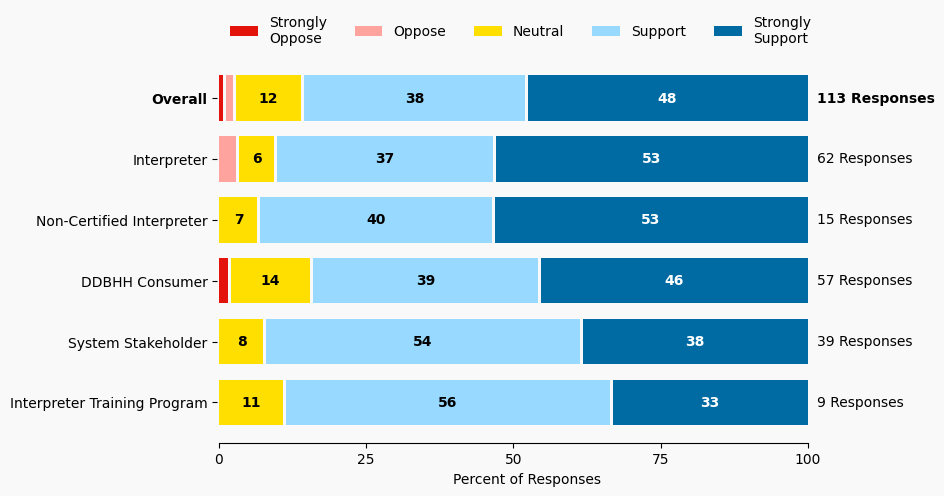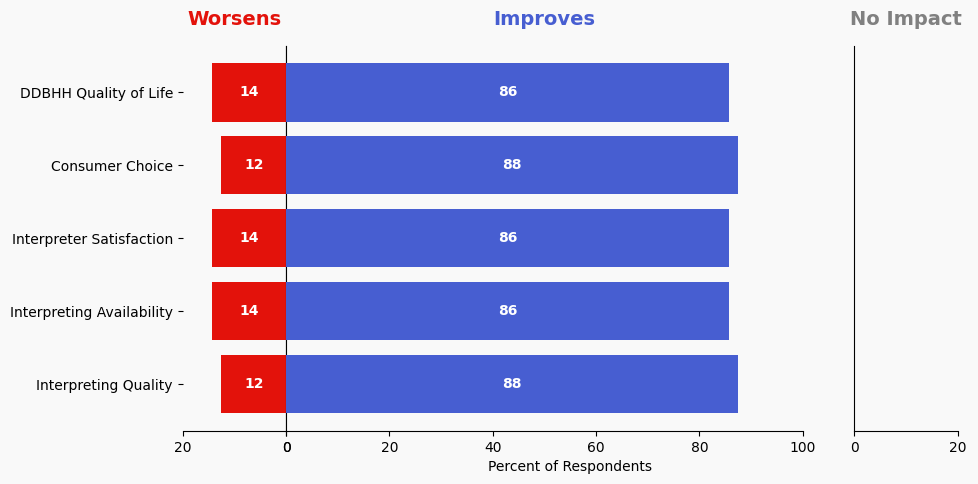104 Diversify Faculty at ITPs
Issue: Disproportionate representation of white interpreters to a more racially diverse DDBHH community members. BIPOC DDBHH community members rarely receive culturally appropriate interpreters.
Proposed Solution: ITPs seek out and hire more racially diverse interpreter trainers. Consider incentives for racially diverse faculty to move to Minnesota. Ensure that the ITPs and colleges where the faculty are hired are a place where anti-racism awareness and work is already happening.
Expected outcome: Having more racially diverse faculty would help to recruit and retain more racially diverse interpreting students.
Who is impacted: Consumers, particularly BIPOC consumers. Prospective interpreters, particularly BIPOC interpreters.
Timeline: 6 months

Summary of Support Image Description
The stacked bar charts show how respondents rated their level of support and the total number of responses. The percentage for the five support levels is shown from left to right: Strongly Oppose (Dark Red), Oppose (Light Red), Neutral (Yellow), Support (Light Blue), and Strongly Support (Dark Blue).
Respondents may identify with multiple subgroups. The overall level of support is:
Overall
Strongly Oppose: 1%
Oppose: 2%
Neutral: 12%
Support: 38%
Strongly Support: 48%
Click to see the detailed image description for each subgroup.
Interpreter
Strongly Oppose: 0%
Oppose: 3%
Neutral: 6%
Support: 37%
Strongly Support: 53%
Non-Certified Interpreter
Strongly Oppose: 0%
Oppose: 0%
Neutral: 7%
Support: 40%
Strongly Support: 53%
DDBHH Consumer
Strongly Oppose: 2%
Oppose: 0%
Neutral: 14%
Support: 39%
Strongly Support: 46%
Interpreter Training Program
Strongly Oppose: 0%
Oppose: 0%
Neutral: 11%
Support: 56%
Strongly Support: 33%
System Stakeholder
Strongly Oppose: 0%
Oppose: 0%
Neutral: 8%
Support: 54%
Strongly Support: 38%
Overview of Respondents Opting for In-Depth Solution Analysis
After indicating their support level, 5% of the 113 respondents opted in to further assess whether the solution would worsen or improve on five metrics. Of the opt-in reviewers (6 respondents), 83% supported the solution, 0% were neutral on the solution, and 16% opposed the solution.
The remaining 107 respondents did not opt in to further assess the solution. Of these people, 85% support the solution, 12% were neutral on the solution, and 1% opposed the solution.
Reviewer Evaluation of Solution Effectiveness

Solution Effectiveness Image Description
The stacked bar charts show how respondents assessed the effectiveness of this solution based on five metrics. For each metric, the percentage of respondents is shown from left to right: Worsens (Red), Improves (Blue), No Impact (Gray).
DDBHH Quality of Life
Makes It Worse 14%
Makes It Better 85%
No Impact 0%
Interpreter Satisfaction
Makes It Worse 14%
Makes It Better 85%
No Impact 0%
Consumer Choice
Makes It Worse 12%
Makes It Better 87%
No Impact 0%
Interpreting Availability
Makes It Worse 14%
Makes It Better 85%
No Impact 0%
Interpreting Quality
Makes It Worse 12%
Makes It Better 87%
No Impact 0%
Reviewer Feedback and Insights
Interpreter
Comments from Interpreters mention that ITPs are trying to hire more diverse staff, but there is a significant shortage of interpreter and ASL educators, making it difficult to fill positions. Another comment suggests having multiple instructors teach classes, as relying on a single teacher limits students’ exposure. Comments also express that having more teachers from diverse backgrounds would provide a wider range of perspectives, improving both ASL skills and understanding of diverse signing styles.
Deaf, DeafBlind, Hard of Hearing
Comments from DDBHH Consumers highlight concerns about not feeling qualified or educated enough to access resources from an open employment database that focuses on diverse backgrounds. Another comment emphasizes the need to review ITPs’ curricula, policies, and practices to ensure they are ready to welcome faculty members who are not White, able-bodied, or cisgender.
System Stakeholder
Comments from System stakeholders acknowledge the challenge of hiring diverse staff and suggest creating incentives to mentor future interpreter or ASL educators from graduate programs.
PREVIOUS SOLUTION
103 Encourage Community Input on Interpreter Training Program Curricula
Issue: Consumers and ITPs do not generally have regular communication about ITP curriculum.
NEXT SOLUTION
105 Emphasize ITP Curricula to Aid in Certification
Issue: Students graduating from ITPs struggle to gain certification.
Leave a Reply